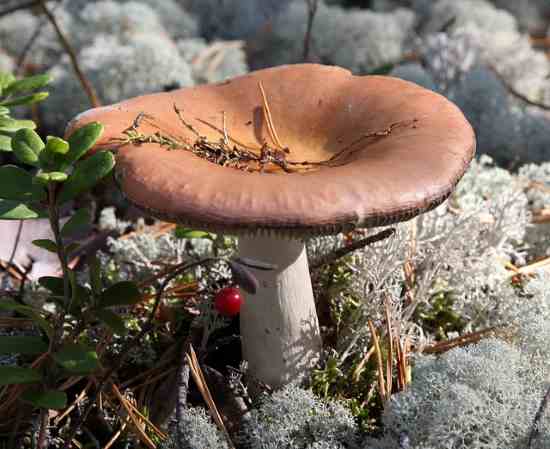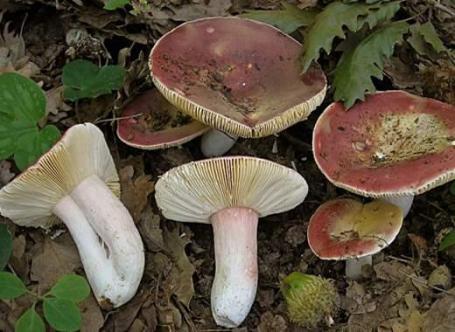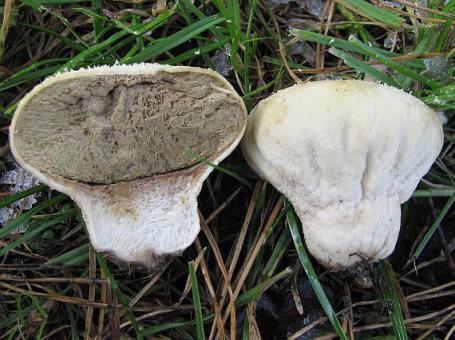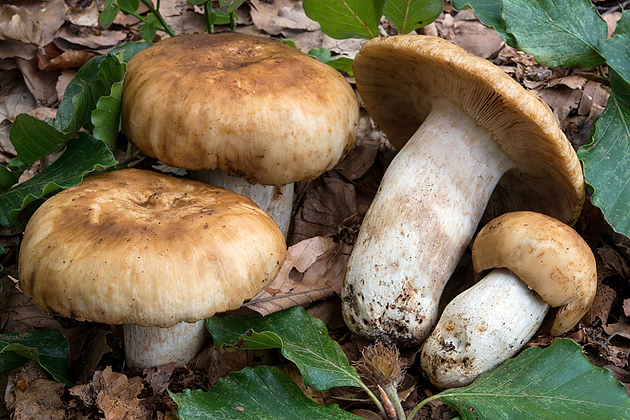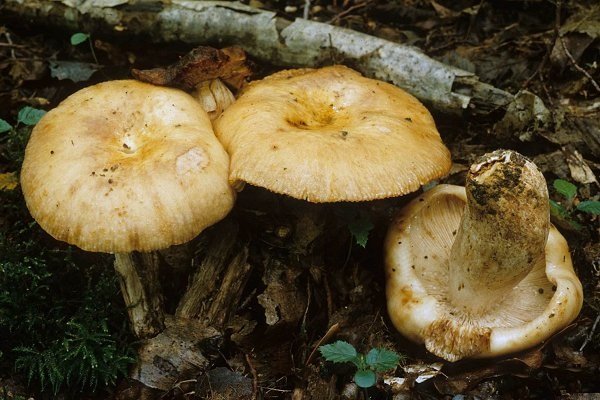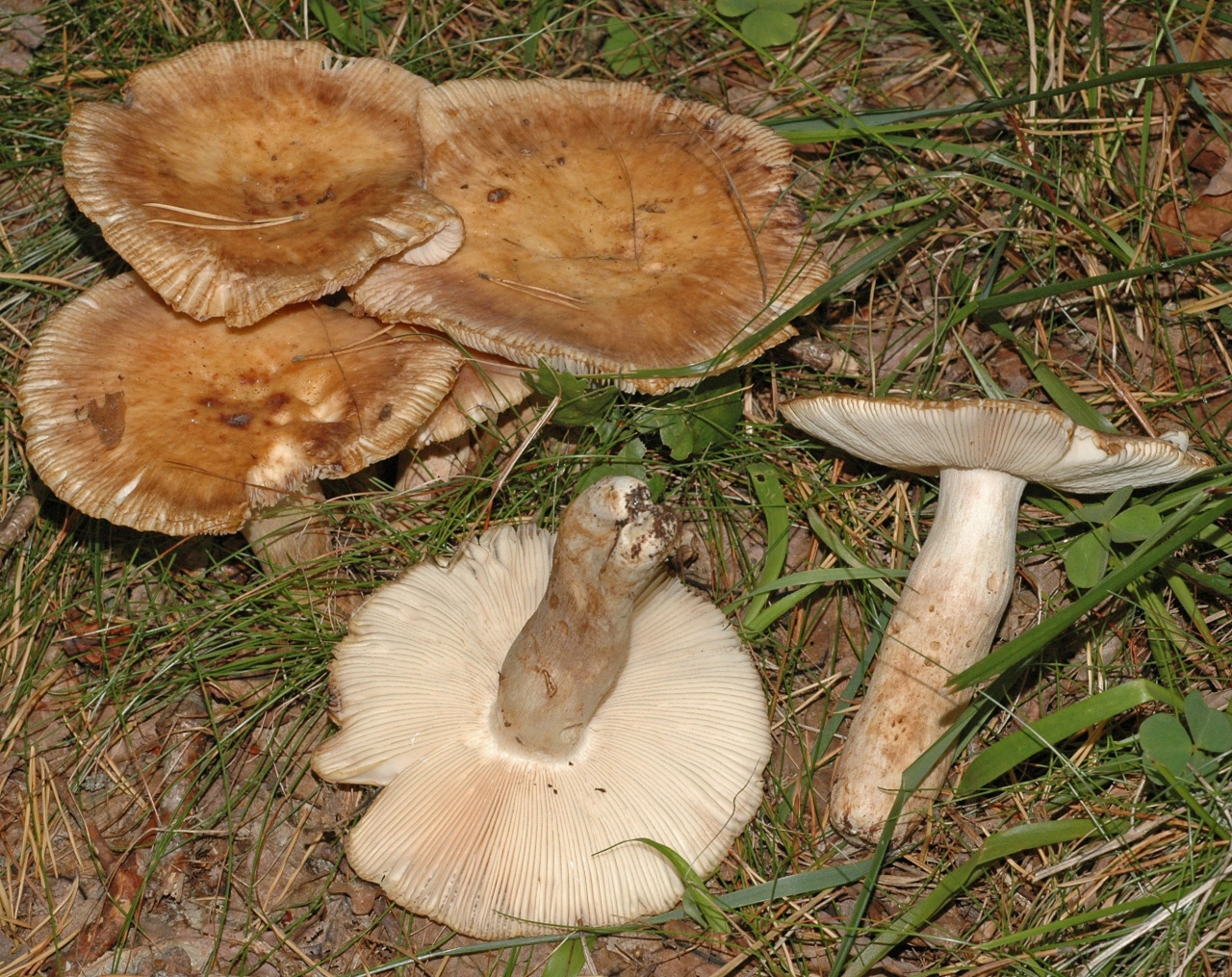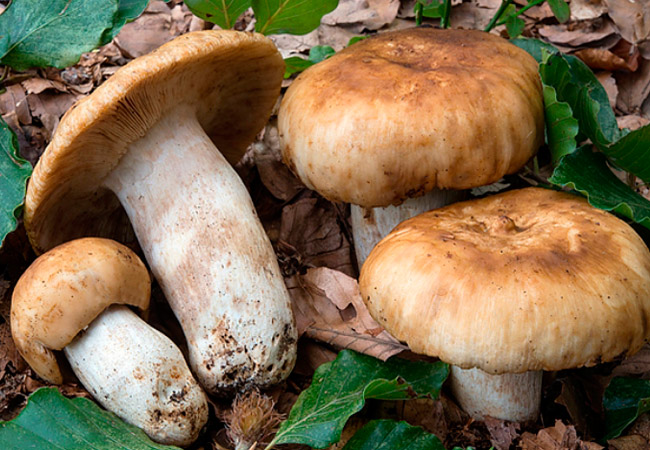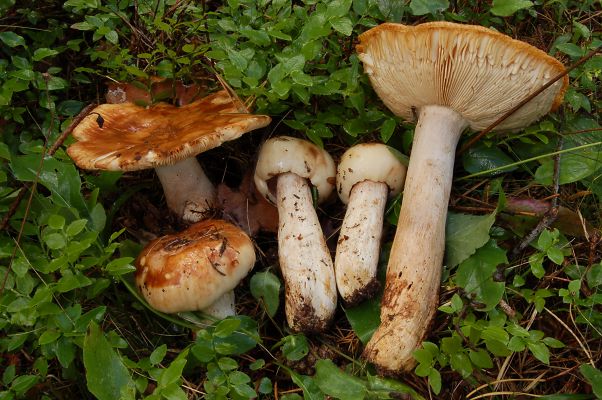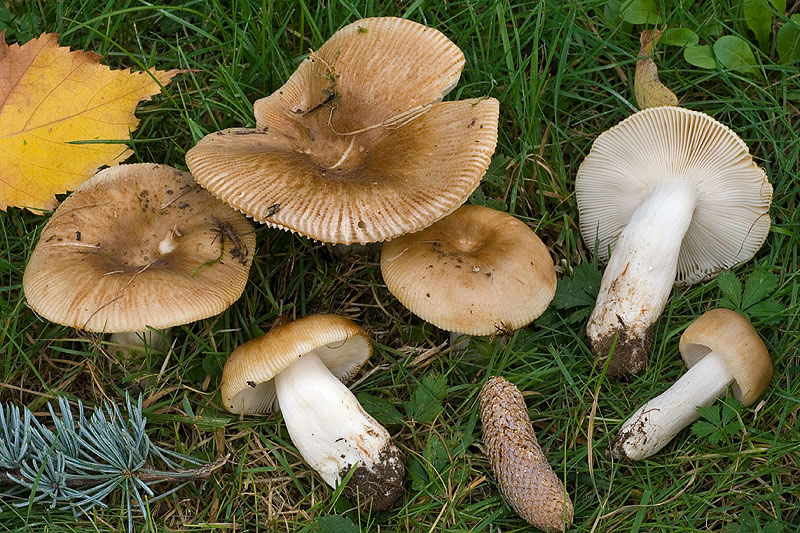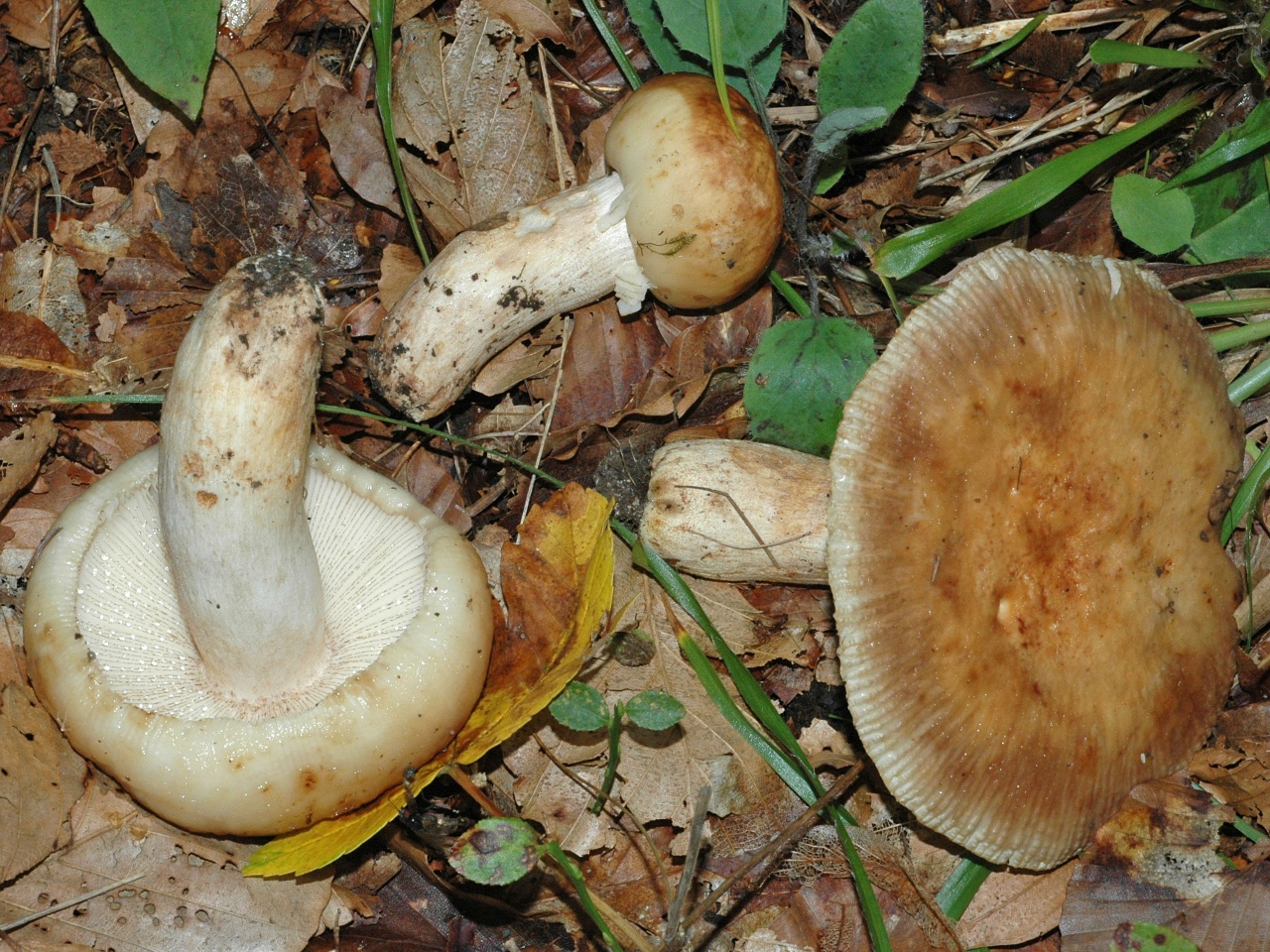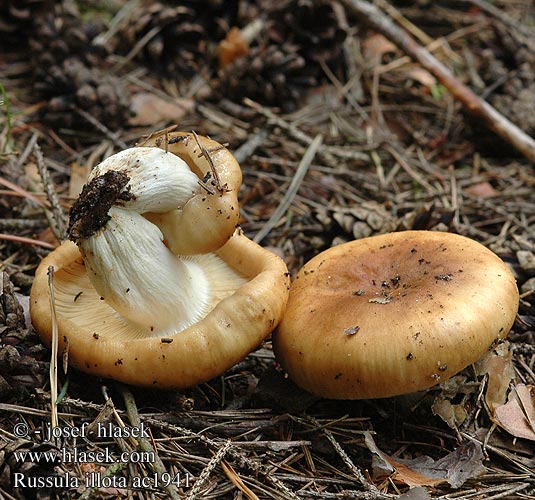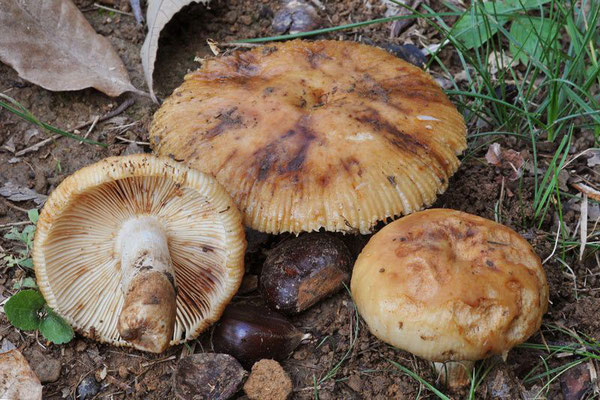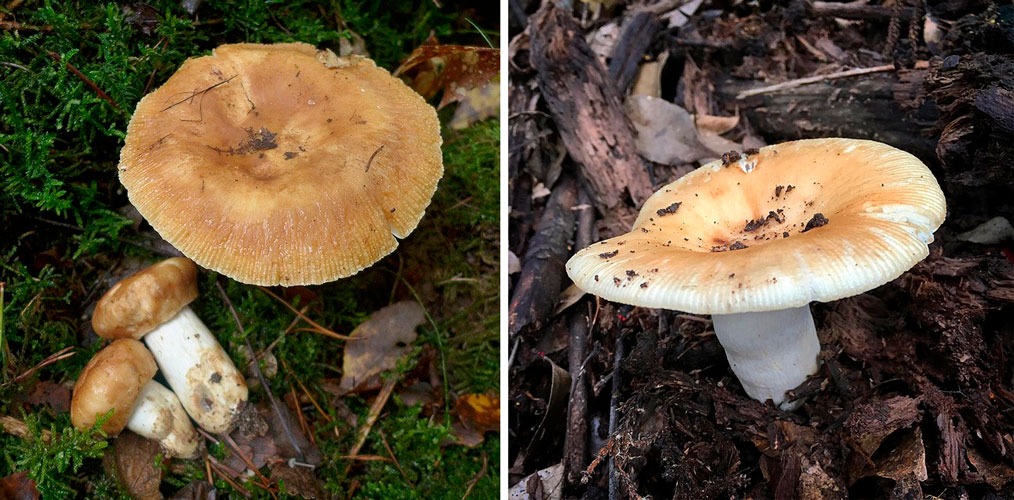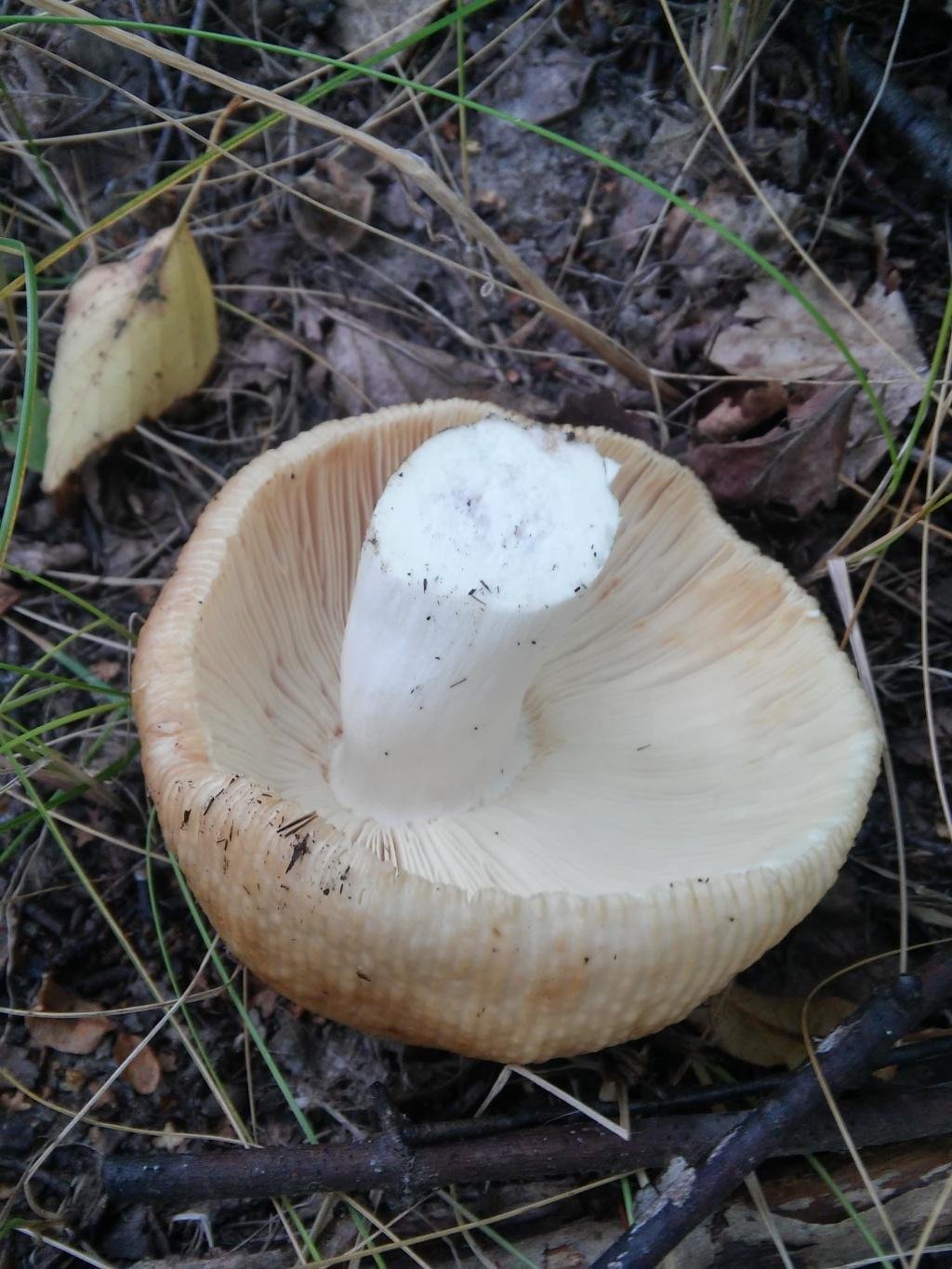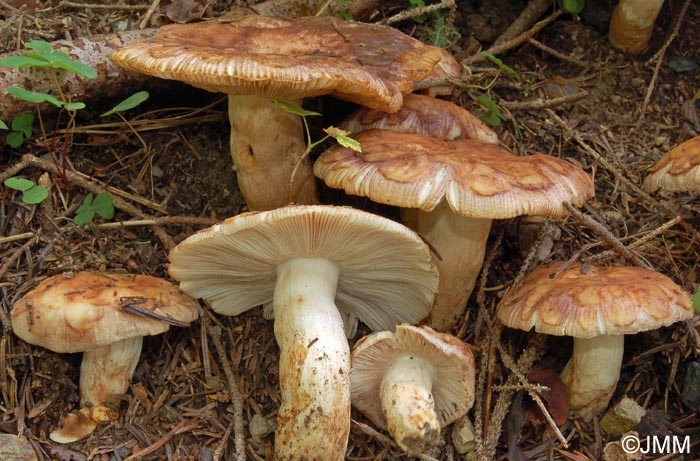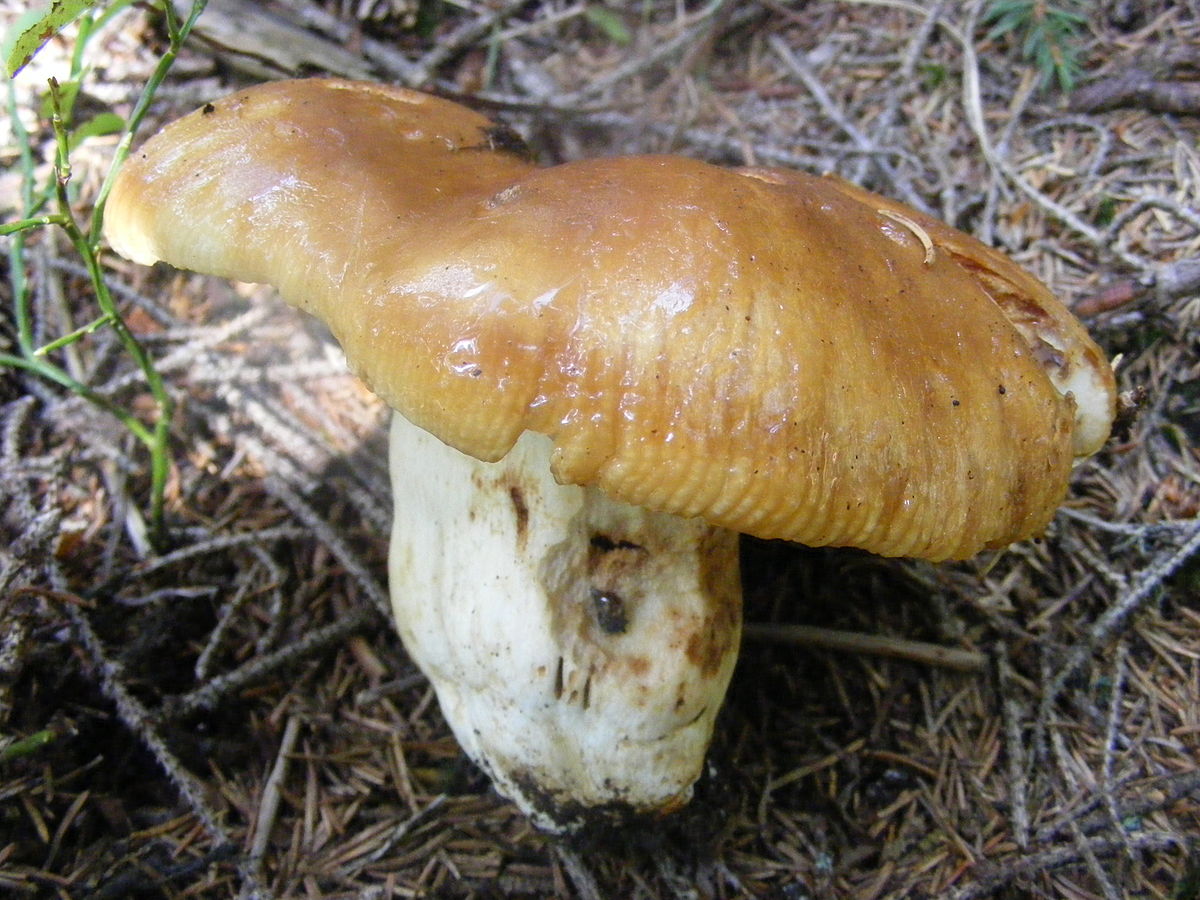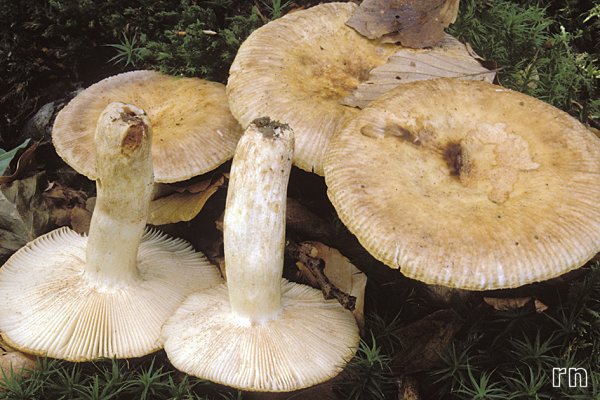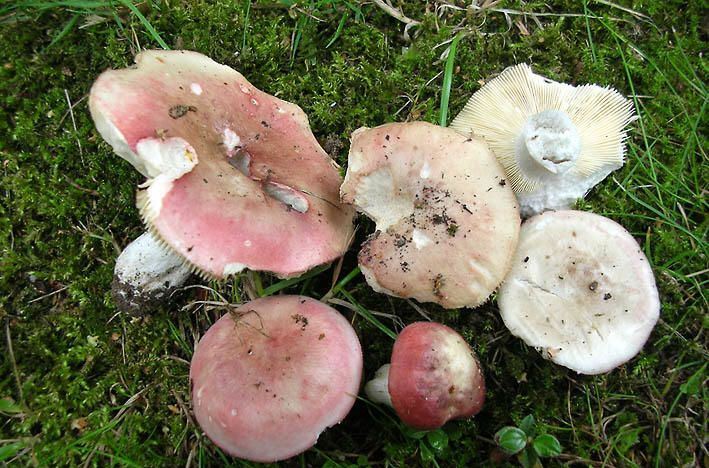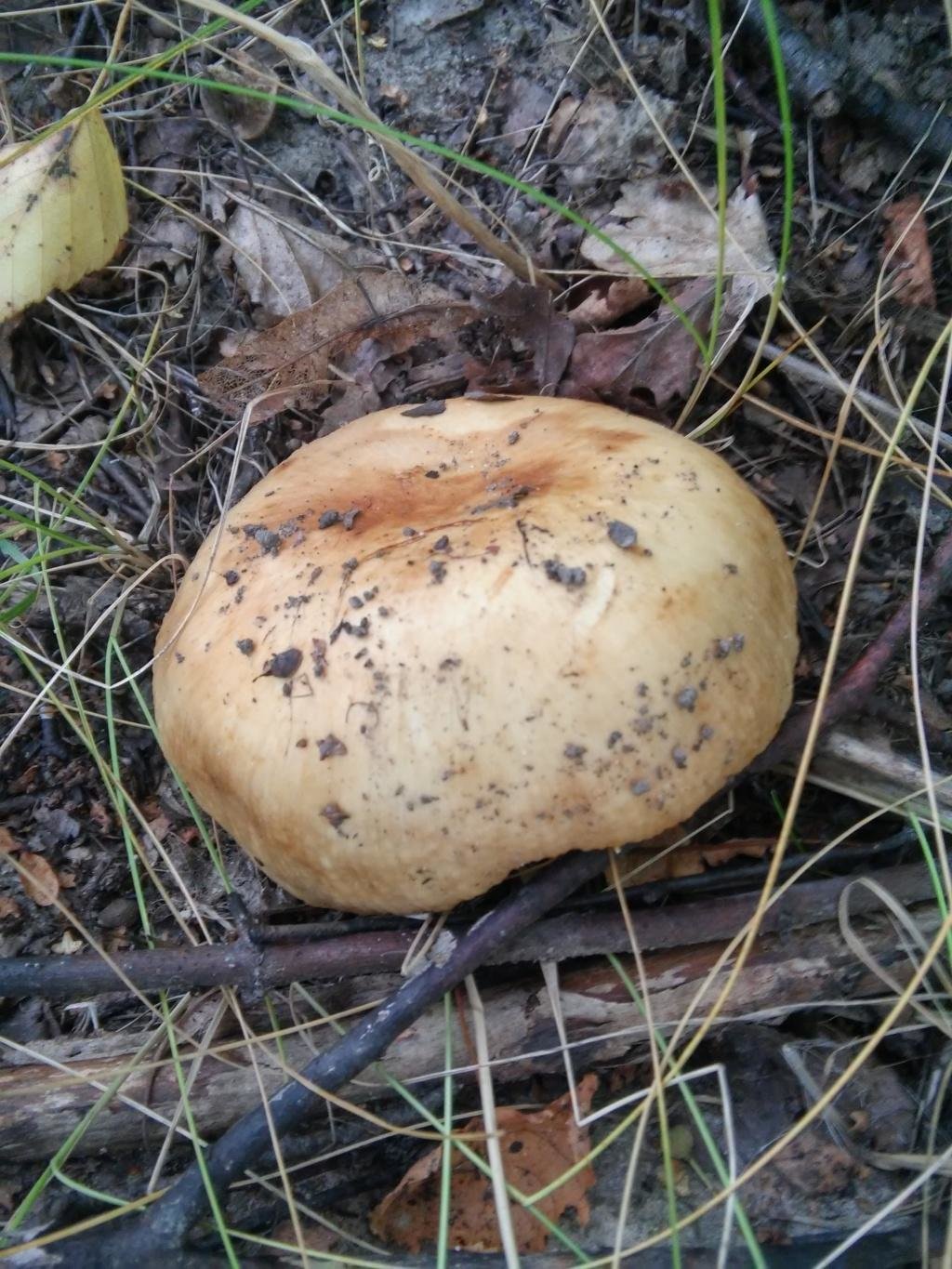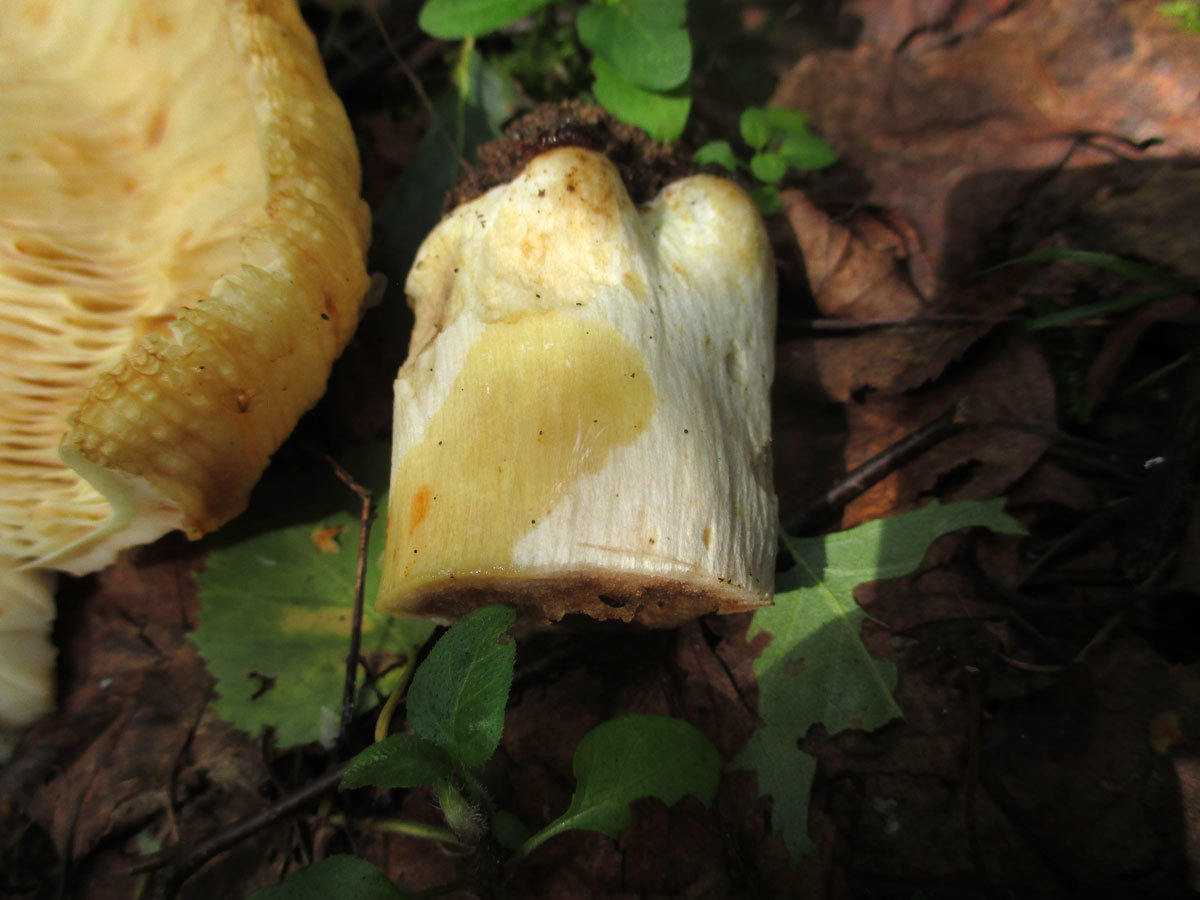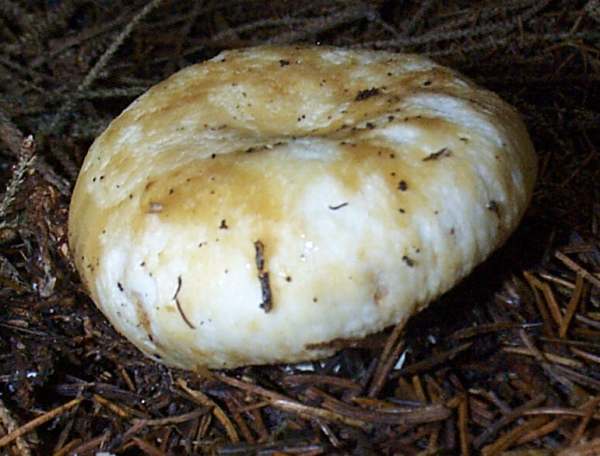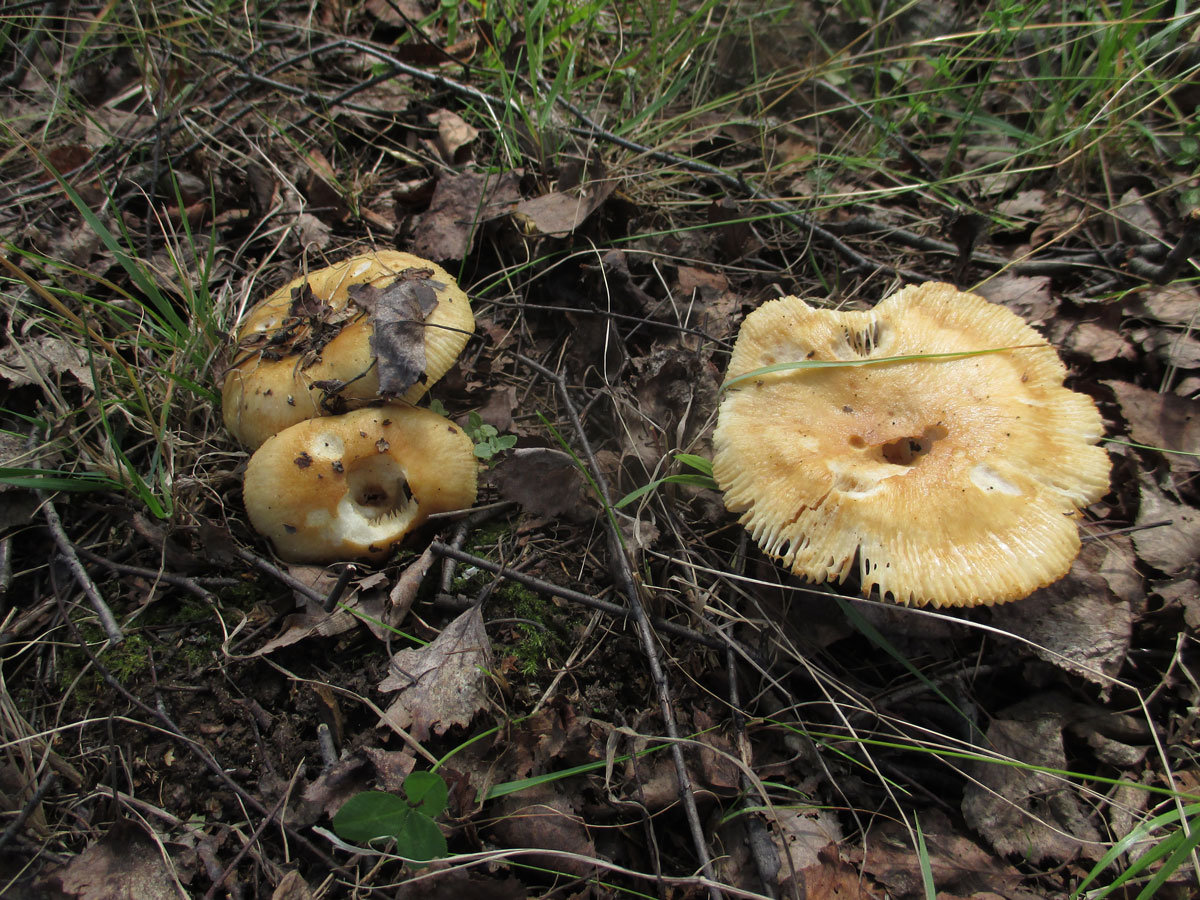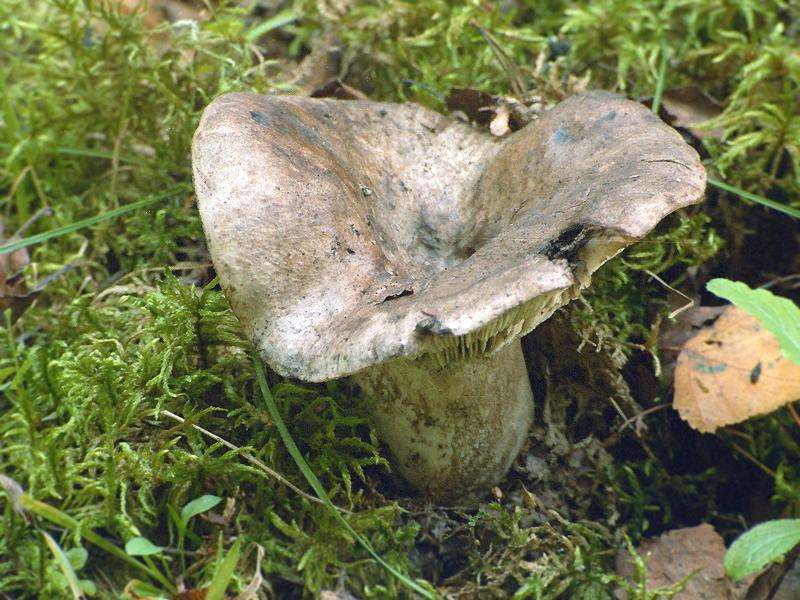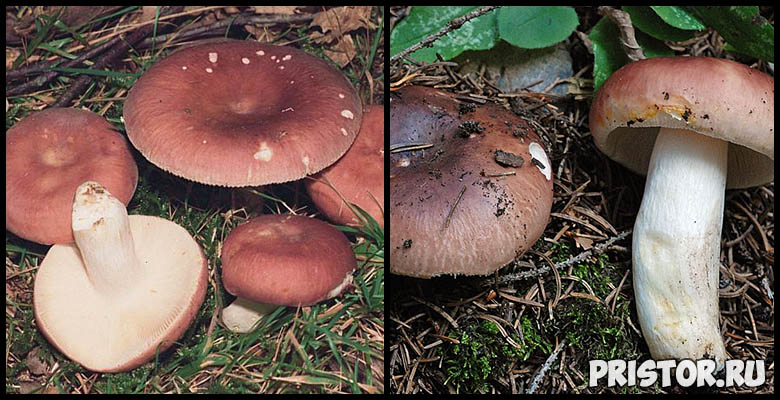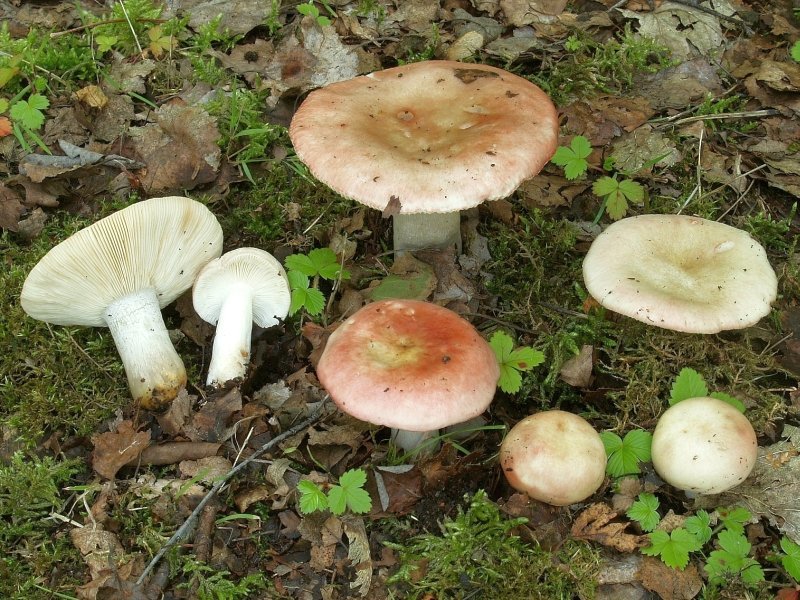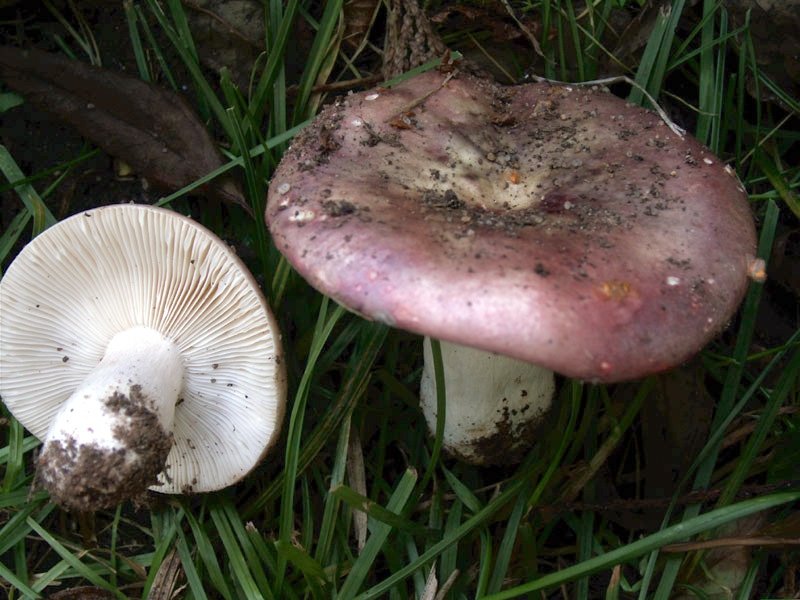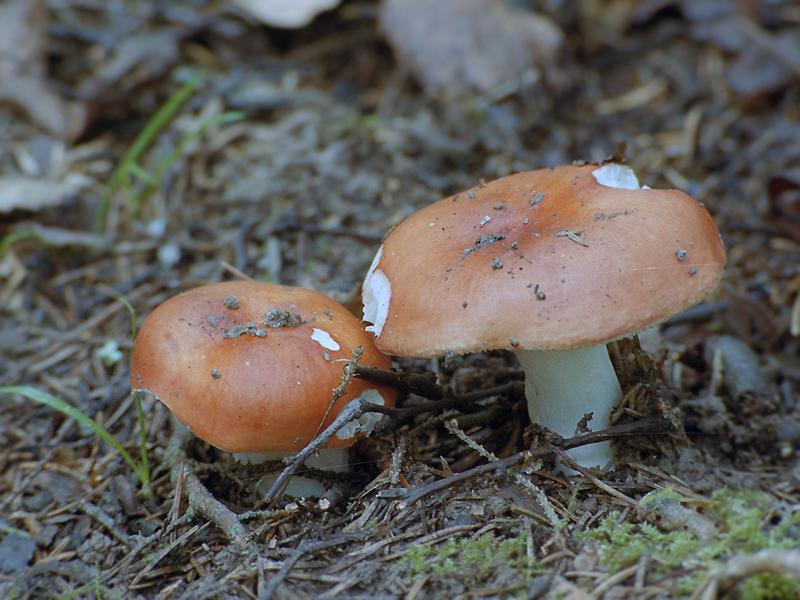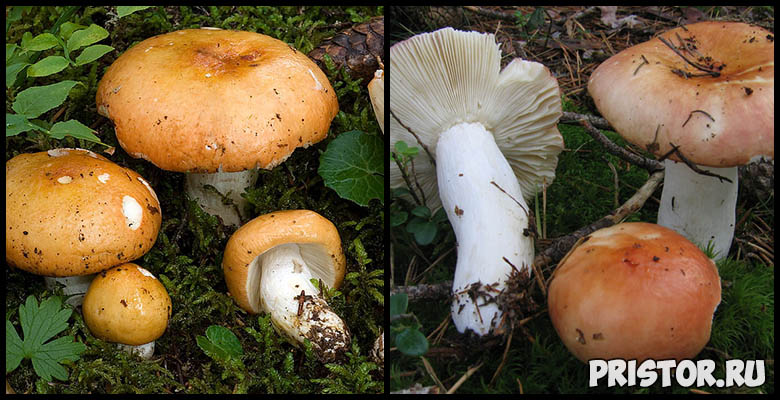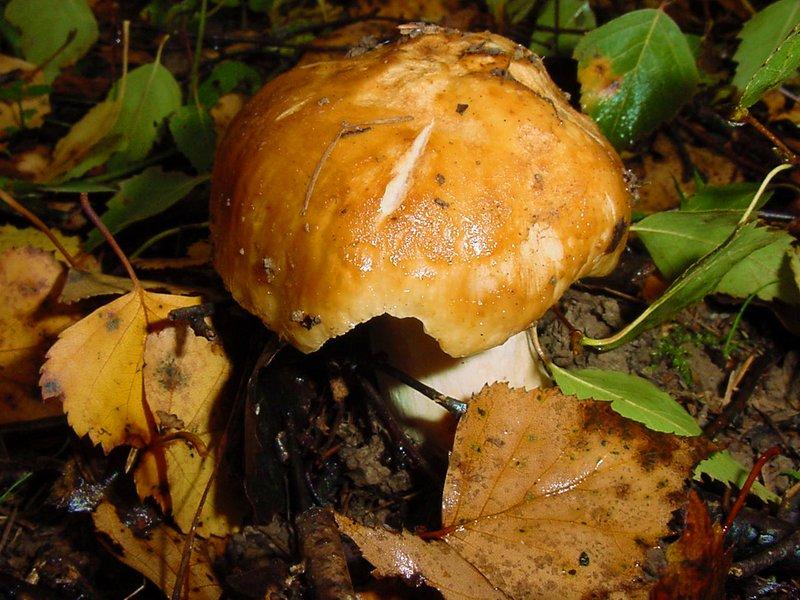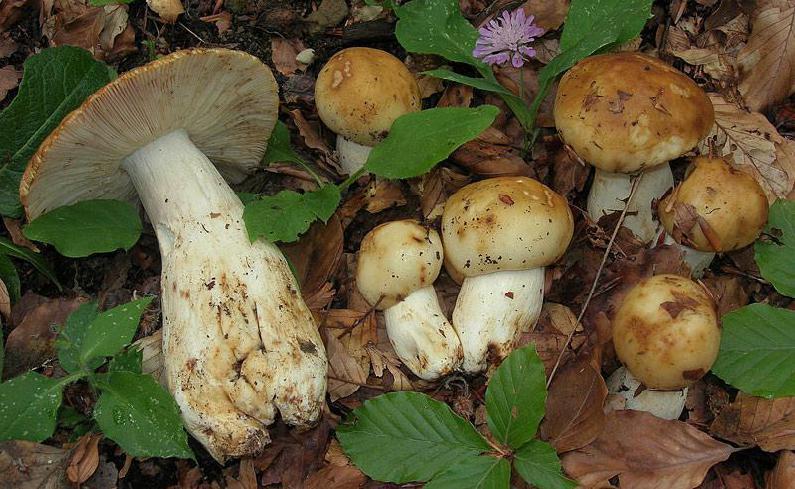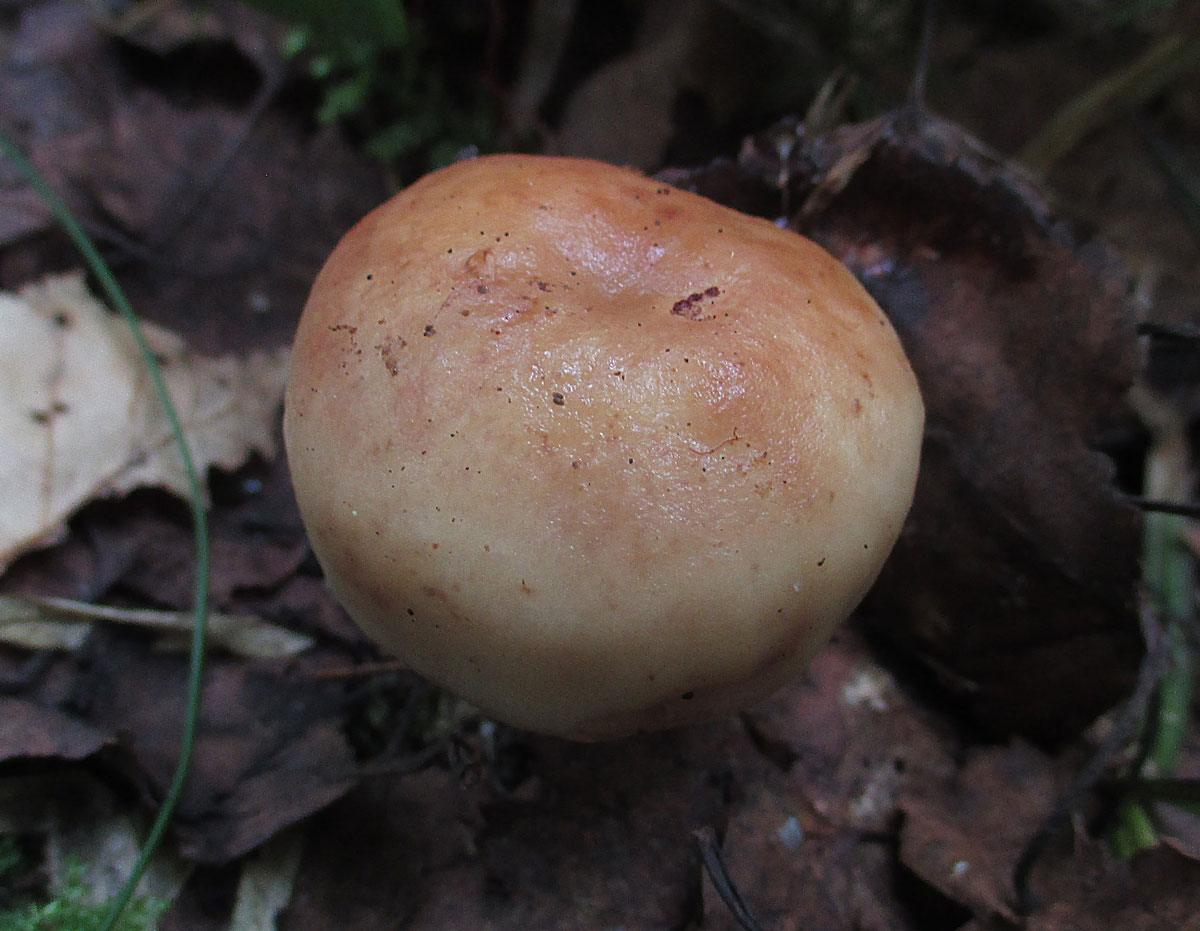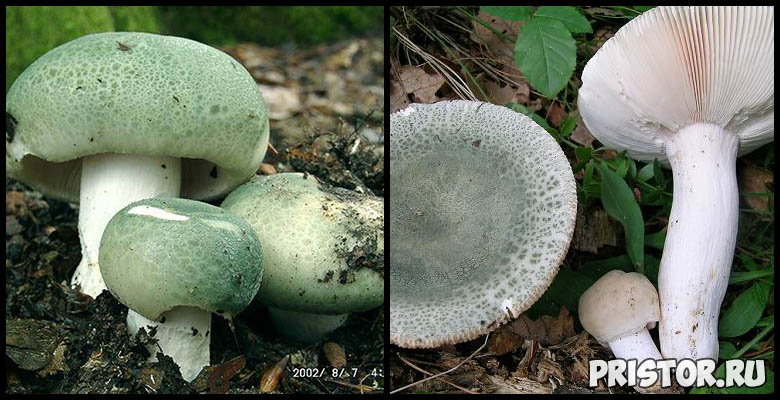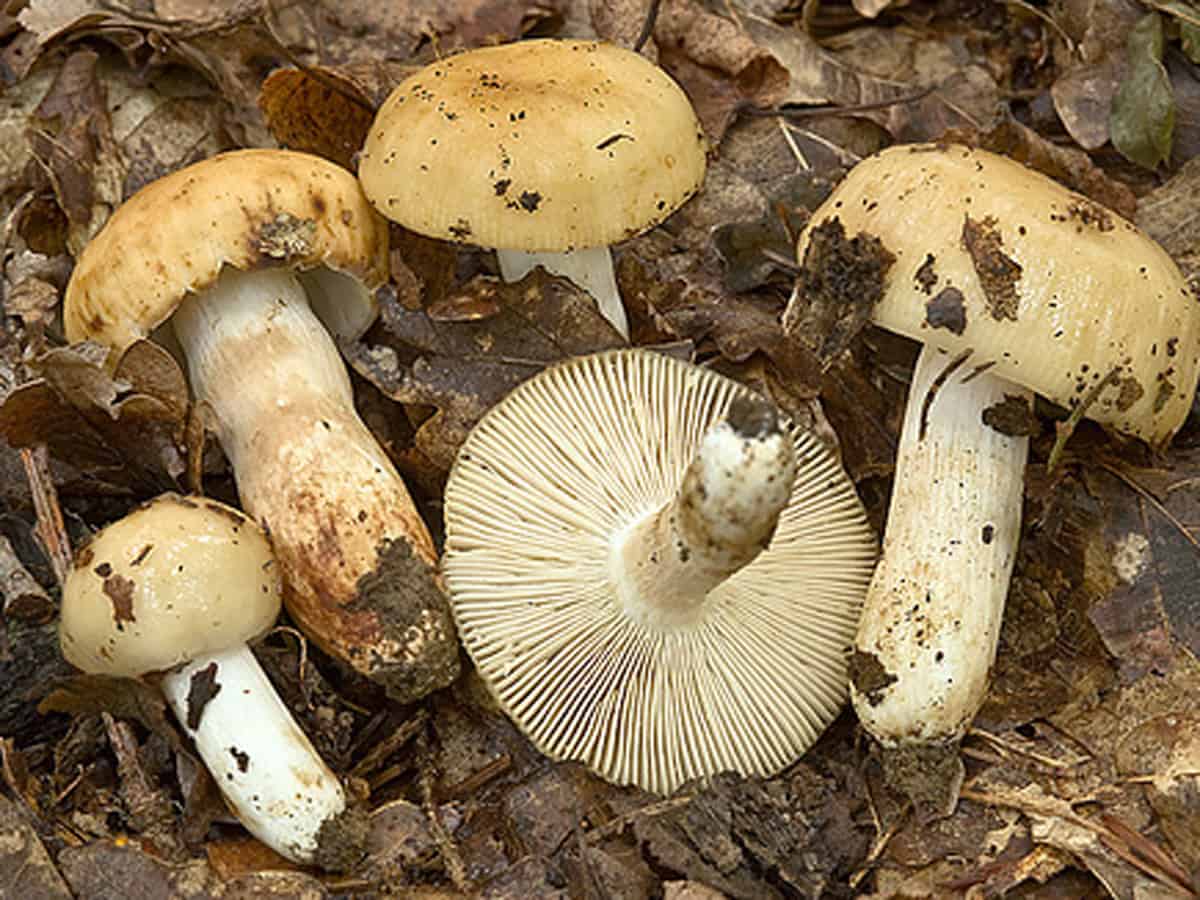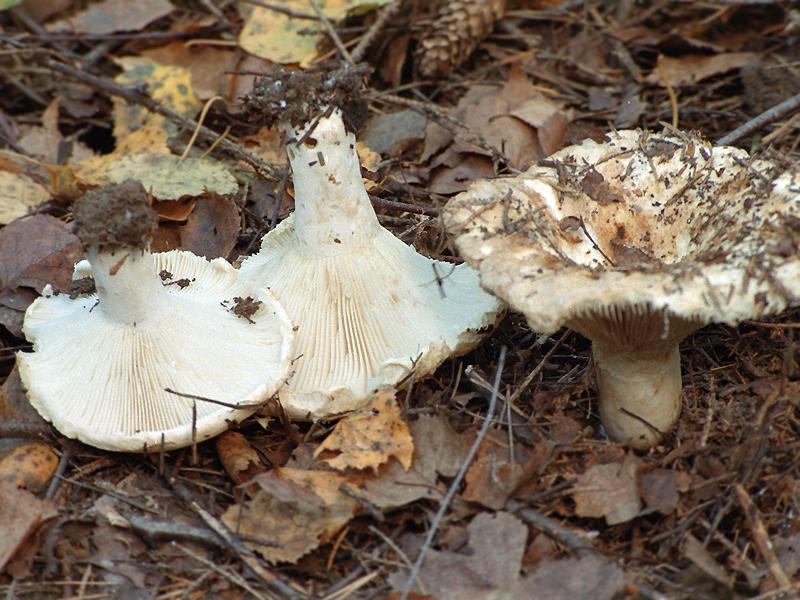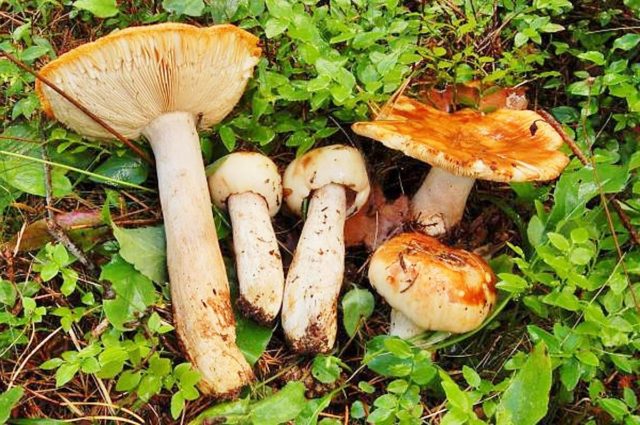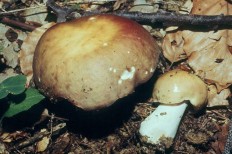Description
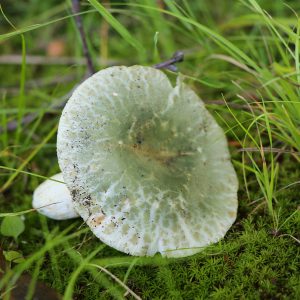 Hat
Hat
Correct rounded shape. In a young mushroom, it has the shape of a hemisphere. As it matures and ages, the cap straightens out, becomes open. A characteristic depression forms in the middle of the cap.
The size of the cap of the scaly russula ranges from 5 to 15 cm in diameter. The structure of the cap is dense, in a young mushroom it is rather hard and fragile.
As a rule, when the mushroom ages and its cap unfolds completely, the skin at the edges becomes torn. The cap is painted green or gray-green, sometimes with whitish spots.
Spore-bearing layer
 Lamellar. Plates adhered to the peduncle, rather sparsely located, fleshy. Painted white, with old age of the fungus they become yellowish or fawn. Spore powder is yellowish-white, spores are colorless, rounded, prickly.
Lamellar. Plates adhered to the peduncle, rather sparsely located, fleshy. Painted white, with old age of the fungus they become yellowish or fawn. Spore powder is yellowish-white, spores are colorless, rounded, prickly.
Leg
Pure white or with a yellowish tinge of color, the leg of the russula scaly reaches a height of about 9-10 cm and from 2 to 5 cm in thickness. In young specimens, the flesh of the leg is solid, in old mushrooms it is hollow. The surface is smooth, the structure is dense and fragile.
Similar species
The biggest danger that lies in wait for the mushroom picker when collecting scale russula is their similarity. This deadly mushroom is most often colored a little lighter, but it happens that it has a greenish tint, making it similar to this type of russula.
To distinguish a scaly russula from a pale toadstool, just look at its leg. There is a characteristic filmy ring on the leg of the toadstool. Also at the base of the leg there is a characteristic egg-shaped depression - a Volvo. In russula scaly, both of these features are absent.
Another double of the scaly russula. But such a mistake does not threaten anything special, the green russula is also edible. Its main difference is a more uniform color of the cap. In addition, the hat can be colored more varied, with gray or brown shades. Old mushrooms have brown spots on the stem.
 1-Pale toadstool 2-Green russula
1-Pale toadstool 2-Green russula
Blackening podgruzdok (Russula nigricans)
or
Russula blackening
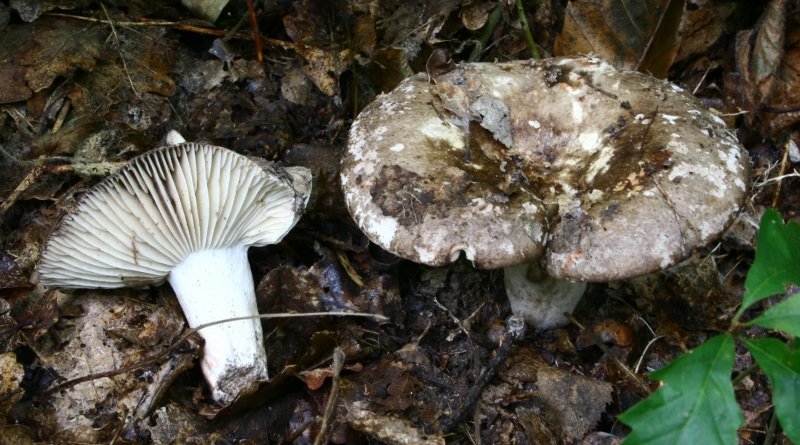
Blackening podgruzdok - a type of mushroom included in the genus russula, belongs to the russula family.
It has a cap from 5 to 15 centimeters (sometimes larger specimens are found - even up to 25 centimeters in diameter). At first, the cap is whitish in color, but then it becomes dirty grayish, brown with a shade of soot color. There are also brownish specimens with an olive tint. The middle of the cap is darker and the edges are lighter. On the cap there are adhering particles of dirt, earth, forest debris.
The blackening podgruzdok has a smooth, dry cap (sometimes with a slight admixture of mucus). It is usually convex, but then becomes flat and spread. Its center becomes smooth over time. Cracks may form on the cap, which expose a beautiful white flesh.
The plates of the fungus are thick, large, and sparsely located. At first they are white, and then they turn gray or even brownish, with a pinkish tint. There are also atypical black plates.
Leg Loading blackening - up to 10 centimeters. It is strong, cylindrical in shape. As the fungus ages, it becomes a dirty brown color.
The pulp of the mushroom is thick, breaking. Usually white, slowly turns reddish at the site of the incision. It has a pleasant taste, slightly bitter, and a pleasant weak aroma. Ferrous sulfate turns this pulp pink (then it turns green).
Distribution area, growing time
The blackening podgruzdok forms mycelium with hard tree species. Grows in deciduous, mixed forests. Also, the mushroom can often be seen in spruce and deciduous forests.A favorite place of distribution is the temperate zone, as well as the region of Western Siberia. The mushroom is not rare in Western Europe either.
In the forest, it is found in large groups. Begins to bear fruit in mid-summer, and this period ends until winter. According to the observations of mushroom pickers, it is found in such a northern region as the Karelian Isthmus, at the end of the forest it is not uncommon in the Leningrad region.
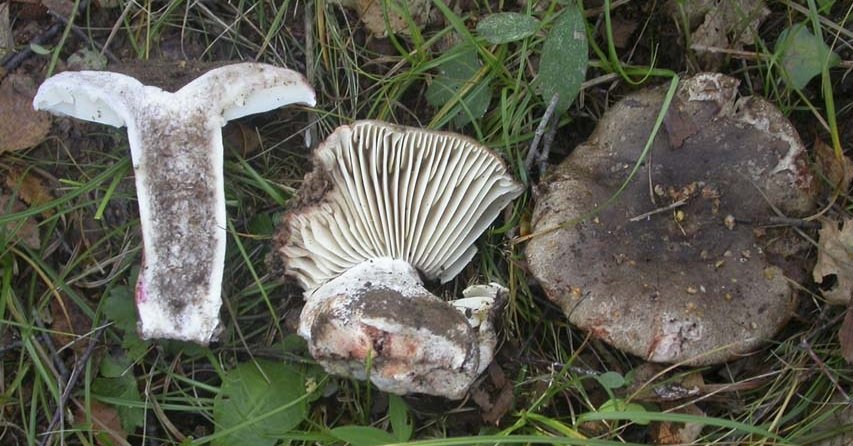
Mushroom twins
- Podgruzdok white and black (Russula albonigra). He has thick and falling plates, as well as a whitish hat, a grayish tint. The pulp of such a mushroom can turn black almost immediately. Redness is not visible in such mushrooms. In autumn, in birch and aspen forests, it is quite rare.
- Lamellar podgruzdok (Russula densifolia). It is distinguished by a brownish-brown and even brownish cap with a black tint. The plates of such a cap are very small, and the mushroom itself is smaller. The pulp first turns reddish, but then slowly turns black. In autumn, in coniferous and mixed forests, it is quite rare.
- The podgruzdok is black. When broken or cut, the flesh of this mushroom turns brown. But it has almost no dark, almost black shades. This mushroom is an inhabitant of coniferous forests.
These types of mushroom, as well as Podgruzdok blackening itself, form a separate group of mushrooms. They differ from others in that their flesh acquires a characteristic black color. Old mushrooms of this group are rather tough, and some of them can have both white and brown shades.
Is this mushroom edible
Blackening podgruzdok belongs to the fourth category of mushrooms. It can be eaten fresh (after boiling thoroughly for at least 20 minutes), as well as salted. In salty form, it quickly takes on a black tint. You need to collect only young mushrooms, since the old ones are quite tough. Moreover, they are almost always wormy. However, Western researchers consider this mushroom to be inedible.
Video about the blackening Podgruzdok mushroom:
additional information
The fungus can grow in the substrate. Some old specimens of the fungus can come to the surface, this breaks the soil layer. The fungus can often be wormy. Another characteristic feature of the fungus is that it decomposes slowly in natural conditions. During decomposition, the mushroom turns black. Dried mushrooms persist for quite a long time, up to the next year.
Description of russula brittle.
At an early age, her cap has a convex shape, but gradually it opens and reaches a concave one. Its diameter is 2.5-6 centimeters. A feature of the fragile russula is that it changes color - at first, the color of its hat is pink-purple, but over time it fades. Along the edge of the cap there are short scars from translucent plates, pink-violet or greenish-gray.

The pulp has a very pungent taste. The plates remain white for a long time, but gradually turn yellow. Spores have an amyloid reticular pattern, their shape is elliptical. The spores themselves are colorless, and the spore powder is white.
The leg is cylindrical, flat, thin-striped. Its length is 3-7 centimeters, and the girth ranges from 5 to 15 millimeters. The color of the leg is white, the surface is mealy.
Areas where russula brittle grow.
This type of russula is often found. Brittle russula settle in conifers and mixed forests. They are found under oaks, pines, birches and hornbeams. They are harvested from August to October, in rare cases they can begin to bear fruit as early as June.

Brittle russula are common in central Russia, Karelia, Ukraine, Belarus and the Baltic states.
The benefits of russula brittle.
Brittle russula are a valuable source of minerals, protein and vitamins. Vitamin PP, contained in fragile russula, improves the functioning of the nervous system, heart, blood vessels, gives the skin elasticity. Vitamin E, found in russula, contributes to the saturation of tissues with oxygen, is an antioxidant, nourishes the mucous membranes and skin.Vitamin C, also found in these mushrooms, is essential for the immune system and for strengthening blood vessels. In addition, brittle russula contain B vitamins, without which metabolic processes do not occur.

In addition to vitamins, brittle russula are rich in iron, phosphorus, calcium, sodium, potassium and magnesium. Also important in their composition are monosaccharides, disaccharides, amino acids, dietary fiber, fatty acids and lecithin.
Brittle russules are low in calories, so they are shown to people suffering from obesity. There are only 19 kcal per 100 grams of the product.
General description of russula
Hat
they have
spherical or hemispherical.
As the fruiting body ages, it
takes on an open appearance, becomes
flat. Some species have a characteristic
funnel in the central part.
Colour
hats can be varied. By
type
she happens
dry, damp, dull or cracking.
Leg
cylindrical,
less often it is perfectly flat. Inside
it happens
how empty
so tight.
Pulp
good
density,
enough
fragile, spongy type. On contact
with oxygen often
changes
its color to gray, brown, black, red.
The first russula grow in the month of July, and reach its peak fruiting at the end of summer. They mostly prefer to settle under deciduous trees.
Description of the forked russula.
The shape of the cap of the forked russula at a young age is hemispherical, after which it is transformed into a depressed one or becomes wide-funnel-shaped. Its diameter is 5-12 centimeters. The color of the cap can be varied - gray-green, yellowish-green, bluish-green, brownish, sometimes yellow. In this case, the central part of the cap is olive or black-brown. The skin is dry, velvety, removable at the edges of the cap.

The plates are located very often. Around the leg, the plates intertwine, descend onto the leg, and then grow to its surface. The color of the plates is creamy, sometimes greenish-yellow. Sometimes there may be red-brown spots on the surface of the plates.
The leg has the shape of a cylinder, sometimes it narrows downwards, it becomes almost conical. The color of the leg is white. In humid weather, the surface of the leg is covered with yellow spots.
The flesh of the forked russula is strong. The color of the pulp is white, sometimes it turns slightly yellow in the air. She does not have a special smell, but her taste is sweetish. Upon contact with ferrous sulfate, the flesh of this mushroom turns pink or orange.

The spores of the forked russula are almost spherical or pear-shaped. There is a poorly developed mesh on the surface of the spores. The color of the spore powder is white.
Places of growth of forked russula.
Fork russula are numerous throughout Europe. These mushrooms grow in deciduous forests, in which there are aspens and birches. Fruiting occurs in them quite abundantly, sometimes they are found in whole glades. Fork russula are harvested from July to September.

Evaluation of the edibility of the fork russula.
Fork russula belongs to edible russula. Her taste is pleasant, without bitterness. Collect these mushrooms carefully, as they are quite fragile.
A dangerous resemblance.
Russula can be confused with pale toadstools. You can recognize a dangerous mushroom by its leg, in the lower part of which there is a tuberous thickening, while the forked russula has a narrowed leg. In addition, at a young age, pale toadstools have a white film under the cap, and in old age a ring remains on the leg. Sometimes on the cap of a pale toadstool there are pieces of the bedspread hanging down with scales.

Related species.
Fading russula is a conditionally edible relative of the forked russula. At a young age, her hat is hemispherical, then it becomes a little open. The color of the cap is blood red. The surface is velvety, often cracking. The leg is white, sometimes with a yellowish tinge.The pulp is very tough, has a bitter taste, and is white in color.
Russula grow fading in deciduous forests. You can find these mushrooms among the beech roots; they rarely settle under coniferous trees. They love calcareous soils. Fruiting is observed from summer to autumn.

The green-red russula, like the forked russula, is an edible mushroom. The shape of its cap is hemispherical, flat or depressed, fleshy in structure. Its color is red-brown or violet-red. Leg with cotton pulp, its surface is smooth, white.
Green-red russula grow in birch groves with an admixture of maple and oak. They grow singly or in small groups. Fruiting from July to September.
Brown russula
Brown russula - lat. Russula xerampelina
In another way, it is called russula brownish purple, russula fragrant or russula brownish burgundy.
External characteristics
Mushroom cap
The aromatic russula grows large caps with a diameter of 35-105 mm, which are convex at a young age, in an adult they are flatter, in the form of a funnel with a depression.
The surface is painted in red-violet color, the middle - in black-violet. Occasionally the hat is covered with brown spots. On fine days, it is velvety and dull, on rainy days it emits a little mucus and shines.
The bottom is formed by frequent accreting white plates, yellowing and turning brown as the mushroom matures.
The hats (and legs) fill with a taut and fleshy yellowish flesh that turns brown when damaged.
The fungus reproduces by elongated mesh spores of a pale yellow or ocher hue.
Stipe
Brown russula (aromatic russula) has a rounded leg - filled in young mushrooms and empty in adults. The height of the legs reaches 70-80 mm, the thickness is 20-30 mm.
They are smooth and wrinkled, widened at the base, and are colored white - pink or white - carmine, often covered with brownish - red spots.
Brown russula - Latin Russula xerampelina
Places of growth and fruiting
The mushroom chooses conifers for growth, consisting of spruce and pine trees, it is found in deciduous forests with oak and birch. It is often found on the plains and mountains of the Eurasian continent.
Fruiting occurs in small groups or singly, from July to early October.
Similar species
Brown russula burgundy resembles the following edible species:
- Almond russula. It is distinguished by a brownish - honey or ocher cap, an almond smell and a pungent taste.
- Russula golden-red. Her hat has a brick or red-yellow color, occasionally tinges with purple. The flesh of the mushroom tastes sweet, but does not smell.
- Whole russula. It differs from the brownish counterpart by the combination of several tones in the color of the hats: yellow-olive, blood-red and brown. At the bottom of her legs there are specks of a yellowish tint. The flesh of the grown mushrooms has a pungent taste.
Brown russula (aromatic russula) has an excellent taste and a pronounced herring smell, unusual for mushrooms, which disappears after boiling and frying. This mushroom is eaten not only fried and stewed, but also salted and pickled.
Inedible mushrooms
It should be noted right away that inedible
russules are quite few. Also, many
carry out several heat treatments
so that their fruiting bodies are still
could be consumed. Inedible
russula do not contain
toxins. Instead, their fruiting bodies
very bitter.
Inedible species include:
- Stinging.
- Blood red.
- Mayr's russula.
- Spicy.
- Birch.
Stinging
Mushroom
very tasteless. No wonder he has
the second name is russula emetic.
The fruiting body is quite pungent
taste. And the bitterness is so strong
that it is enough just to touch
lips to the moist fruiting body (especially
to the hat). Immediately there will be a strong
tingling that will go through
A couple of minutes. Stinging cap size
russula can reach 11 cm in diameter.
Blood red
It is an inedible species due to its
strong bitterness. It should be understood that when
high consumption of fruit bodies
blood red russula may be observed
mild gastrointestinal upset. Her hat
usually grows up to 10 cm in diameter.
Mayr's russula
It is inedible as it contains
a large number of
burning, irritating substances. At
eating fruit bodies with such
substances can be weak
signs of poisoning. Long-term
soaking and boiling does not eliminate
bitterness from fruit chalk. On average, her
the cap grows up to 9 cm in diameter.
Spicy
In general, it belongs to the 4th group of edibility. However, those who are familiar with its fruiting bodies note that it should not be eaten. The reason for this is the high content of burning substances in its composition. If not cooked correctly, there may be a mild gastrointestinal upset that causes stomach pain. Her hat is medium in size, can reach 10 cm in diameter.
We also recommend reading: Description of poisonous mushrooms
Birch
In general, it belongs to the category of conditionally edible. However, due to its poor taste, many consider it inedible. It is categorically impossible to eat raw mushrooms, as this will most likely lead to an upset gastrointestinal tract. The size of the birch cap can vary within 5 cm. That is, these are rather small mushrooms.

